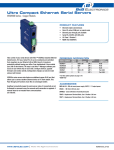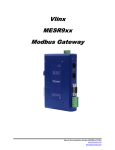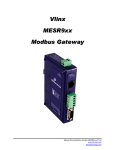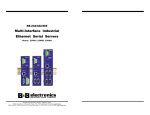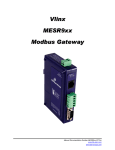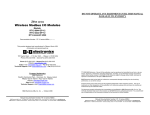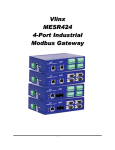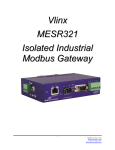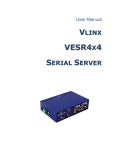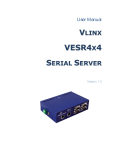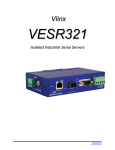Download B&B Electronics Serial Servers Vlinx VESR9xx Product specifications
Transcript
VESR9xx Serial servers www.bb-elec.com www.bb-europe.com i Vlinx Serial Servers Model VESR9xx Documentation Number: VESR9xx_4113m This product designed and manufactured in Ottawa, Illinois USA using domestic and imported parts by International Headquarters 707 Dayton Road - P.O. Box 1040 - Ottawa, IL 61350 USA Phone (815) 433-5100 - General Fax (815) 433-5105 Website: www.bb-elec.com European Headquarters B&B Electronics Westlink Commercial Park - Oranmore, Co. Galway, Ireland Phone +353 91-792444 - Fax +353 91-792445 Website: www.bb-europe.com B&B Electronics Mfg. Co. Inc – October 2013 ©2010 B&B Electronics Mfg Co Inc No part of this publication may be reproduced or transmitted in any form or by any means, electronic or mechanical, including photography, recording, or any information storage and retrieval system without written consent. Information in this manual is subject to change without notice, and does not represent a commitment on the part B&B Electronics Mfg Co Inc. B&B Electronics Mfg Co Inc shall not be liable for incidental or consequential damages resulting from the furnishing, performance, or use of this manual. All brand names used in this manual are the registered trademarks of their respective owners. The use of trademarks or other designations in this publication is for reference purposes only and does not constitute an endorsement by the trademark holder. www.bb-elec.com www.bb-europe.com ii TABLE OF CONTENTS Introduction ................................................................................................................. 1 About VESR9xx Serial Servers ........................................................................................ 1 VESR9xx Serial Server Model Numbering ....................................................................... 1 List of VESR9xx Serial Server Models ............................................................................. 3 VESR9xx Serial Server Features ..................................................................................... 5 Vlinx Manager Configuration Software ............................................................................. 5 VESR9xx Serial Server Hardware .............................................................................. 7 Package Checklist ........................................................................................................... 7 VESR9xx Serial Server Enclosures and Mounting ........................................................... 7 LED Indicators(VESR90x) ................................................................................................ 7 Link LED ..................................................................................................................... 8 Ready LED ................................................................................................................. 8 Serial Port LEDs ......................................................................................................... 8 LED Indicators (VESR92x) ............................................................................................... 8 Mode Switch .................................................................................................................... 9 Ethernet Connector ........................................................................................................ 10 Fiber Optic Connectors .................................................................................................. 10 Serial Port Connectors ................................................................................................... 10 Power Connector ........................................................................................................... 11 Mounting Hardware ........................................................................................................ 12 Serial Server Setup and Connections...................................................................... 13 Connecting the Power Supply ........................................................................................ 13 Connecting VESR9xx Serial Servers to Serial Devices .................................................. 13 Connecting the VESR901-x ...................................................................................... 14 Connecting the VESR902T-x .................................................................................... 14 Connecting the VESR902D-x.................................................................................... 15 Connecting VESR9xx Serial Servers to a Network ......................................................... 16 Network Connection (10BaseT/100BaseTX)............................................................ 16 Fiber Optic Connection ............................................................................................ 16 VESR9xx Serial Server Configuration Connections ........................................................ 17 Configuring the VESR9xx Serial Server via the Network Connection ....................... 17 Configuring the VESR9xx Serial Server via the Serial Port (Console Mode) ............. 19 VESR9xx Serial Server Operational Connections .......................................................... 20 Using VESR9xx Serial Servers in Direct IP Mode ...................................................... 20 Using VESR9xx Serial Servers in Virtual COM Port Mode ........................................ 21 Using VESR9xx Serial Servers in Paired Mode ......................................................... 21 Initiating a Hardware Reset on the Serial Server ............................................................ 22 Reloading Factory Defaults ............................................................................................ 22 Description of Serial Server Properties ................................................................... 25 Baud Rate ...................................................................................................................... 25 Character Count............................................................................................................. 25 Configuration Files ......................................................................................................... 25 Data/Parity/Stop ............................................................................................................. 25 www.bb-elec.com www.bb-europe.com iii Default Gateway ............................................................................................................ 25 Delimiter 1, Delimiter 2 and Delimiter Removal .............................................................. 26 Delimiter 1 .............................................................................................................. 26 Delimiter 2 .............................................................................................................. 26 Delimiter Removal................................................................................................... 26 How Delimiters Work .............................................................................................. 26 DHCP ............................................................................................................................ 26 Firmware Version ........................................................................................................... 27 Flow Control................................................................................................................... 27 Forced Transmit ............................................................................................................. 27 Hardware Version .......................................................................................................... 27 Inter-character Timeout .................................................................................................. 28 IP Address ..................................................................................................................... 28 Link Status ..................................................................................................................... 30 MAC Address ................................................................................................................. 30 Model ............................................................................................................................. 30 Network Protocols .......................................................................................................... 31 Network Watchdog ......................................................................................................... 31 Paired Mode .................................................................................................................. 31 Password ....................................................................................................................... 31 Serial Interface Modes ................................................................................................... 31 Serial Server Name ........................................................................................................ 32 Server Serial Port Number ............................................................................................. 32 Serial Watchdog............................................................................................................. 32 Subnet Mask .................................................................................................................. 33 TCP (Transmission Control Protocol) ............................................................................. 33 UDP (User Datagram Protocol) ...................................................................................... 33 VCOM (Virtual COM Port) .............................................................................................. 34 Upgrading the Serial Server Firmware .................................................................... 35 Downloading Firmware Files .......................................................................................... 35 Uploading the Firmware to the Serial Server .................................................................. 36 Diagnostics ................................................................................................................ 37 Testing a Serial Server Connection ................................................................................ 37 Testing a Virtual COM Port ............................................................................................ 38 Appendix A: Default Server Settings ....................................................................... 41 Appendix B: Product Specifications ....................................................................... 42 General Specifications ............................................................................................. 42 Controls, Indicators and Connector Specifications .................................................. 44 Serial Interface Specifications ................................................................................. 45 Network Specifications............................................................................................ 46 Appendix C: Dimensional Diagrams ........................................................................ 47 Appendix D: Connector Pinouts .............................................................................. 51 VESR901 & VESR921 Series ..................................................................................... 51 VESR902D Series ..................................................................................................... 53 VESR902T & VESR922T Series ................................................................................ 54 www.bb-elec.com www.bb-europe.com iv Standard Ethernet Cable RJ-45 Pin-out ................................................................... 55 www.bb-elec.com www.bb-europe.com v Introduction INTRODUCTION Thank you for purchasing a VESR9xx Serial Server product! This product has been manufactured to the highest standards of quality and performance to ensure your complete satisfaction. Figure 1. A VESR902T Serial Server ABOUT VESR9XX SERIAL SERVERS VESR9xx Serial Servers connect serial devices (RS-232, RS-422 or RS-485) to Ethernet networks, allowing the serial device to become a node on the network. The serial ports can be accessed over a LAN/WAN using Direct IP Mode, Virtual COM Port, or Paired Mode connections. VESR9xx Serial Servers feature 10BaseT or 100BaseTX copper network media and several fiber optic media options, depending on the model. VESR92x serial servers feature an additional copper Ethernet pass-through port. VESR9xx Serial Servers are built for use in industrial environments, featuring an IP30 approved slim line DIN rail mountable case. They operate from a range of DC power supply voltages and feature pluggable terminal block power connectors. VESR9XX SERIAL SERVER MODEL NUMBERING VESR9xx Serial Server are a growing family of products. Models are available with one or two serial connections and one or two Ethernet connections. Network connection options include 10BaseT/100BaseTX copper or several different fiber optic options (on models with a pass-through port, the pass-through port is copper). The following diagram shows the model numbering scheme: www.bb-elec.com www.bb-europe.com 1 Introduction www.bb-elec.com www.bb-europe.com 2 Introduction LIST OF VESR9XX SERIAL SERVER MODELS The following table lists the various VESR9xx Serial Server models available. Model Number VESR901 Features Vlinx , 1PORT, DB9, ESS, DIN, CU ETHERNET VESR901-SC40 Vlinx , 1PORT, DB9, ESS, DIN, FIBER, SC, 40KM VESR901-SC80 Vlinx , 1PORT, DB9, ESS, DIN, FIBER, SC, 80KM VESR901-ST VESR901-ST40 VESR901-ST80 VESR902D Vlinx , 1PORT, DB9, ESS, DIN, FIBER, ST Vlinx , 1PORT, DB9, ESS, DIN, FIBER, ST, 40KM Vlinx , 1PORT, DB9, ESS, DIN, FIBER, ST, 80KM Vlinx , 2PORT, DB9, ESS, DIN, CU ETHERNET VESR902D-SC40 Vlinx , 2PORT, DB9, ESS, DIN, FIBER, SC, 40KM VESR902D-SC80 Vlinx , 2PORT, DB9, ESS, DIN, FIBER, SC, 80KM VESR902D-ST40 Vlinx , 2PORT, DB9, ESS, DIN, FIBER, ST, 40KM VESR902D-ST80 Vlinx , 2PORT, DB9, ESS, DIN, FIBER, ST, 80KM VESR902T VESR902T-SC Vlinx , 2PORT, TB, ESS, DIN, CU ETHERNET Vlinx , 2PORT, TB, ESS, DIN, FIBER, SC VESR902T-SC40 Vlinx , 2PORT, TB, ESS, DIN, FIBER, SC, 40KM VESR902T-SC80 Vlinx , 2PORT, TB, ESS, DIN, FIBER, SC, 80KM VESR902T-ST Vlinx , 2PORT, TB, ESS, DIN, FIBER, ST VESR902T-ST40 Vlinx , 2PORT, TB, ESS, DIN, FIBER, ST, 40KM VESR902T-ST80 Vlinx , 2PORT, TB, ESS, DIN, FIBER, ST, 80KM VESR902T-MC Vlinx , 2PORT, TB, ESS, DIN, FIBER, MULTIMODE, SC VESR902T-MT Vlinx , 2PORT, TB, ESS, DIN, FIBER, MULTIMODE, ST VESR921 VLINX, 1PORT, DB9, ESS, DIN, 2 CU ETHERNET VESR921-MC VLINX, 1PORT, DB9, ESS, DIN, FIBER, MULTI, SC, CU VESR921-MT VLINX, 1PORT, DB9, ESS, DIN, FIBER, MULTI, ST, CU VESR921-SC VLINX, 1PORT, DB9, ESS, DIN, FIBER, SC, CU VESR921-SC40 VLINX, 1PORT, DB9, ESS, DIN, FIBER, SC, 40KM, CU VESR921-SC80 VLINX, 1PORT, DB9, ESS, DIN, FIBER, SC, 80KM, CU VESR921-ST VESR921-ST40 VLINX, 1PORT, DB9, ESS, DIN, FIBER, ST, CU VLINX, 1PORT, DB9, ESS, DIN, FIBER, ST, 40KM, CU www.bb-elec.com www.bb-europe.com 3 Introduction Model Number Features VESR921-ST80 VLINX, 1PORT, DB9, ESS, DIN, FIBER, ST, 80KM, CU VESR922T VLINX, 2PORT, TB, ESS, DIN, FIBER, MULTI, SC, CU VESR922T-MT VLINX, 2PORT, TB, ESS, DIN, FIBER, MULTI, ST, CU VESR922T-SC VLINX, 2PORT, TB, ESS, DIN, FIBER, SC, CU VESR922T-SC40 VLINX, 2PORT, TB, ESS, DIN, FIBER, SC, 40KM, CU VESR922T-SC80 VLINX, 2PORT, TB, ESS, DIN, FIBER, SC, 80KM, CU VESR922T-ST www.bb-elec.com www.bb-europe.com 4 VLINX, 2PORT, TB, ESS, DIN, 2 CU ETHERNET VESR922T-MC VLINX, 2PORT, TB, ESS, DIN, FIBER, ST, CU VESR922T-ST40 VLINX, 2PORT, TB, ESS, DIN, FIBER, ST, 40KM, CU VESR922T-ST80 VLINX, 2PORT, TB, ESS, DIN, FIBER, ST, 80KM, CU Introduction VESR9XX SERIAL SERVER FEATURES Three series models VESR9x1-x (single serial port) VESR9x2D-x (two serial ports with DB9M) VESR9x2T-x (two serial ports with pluggable terminal blocks) Fiber models available for each of the above series Ethernet pass through ports are available on VESR92x series models. Multi-interface serial ports DB-9M and pluggable terminal block serial port connector options All ports are software selectable as RS-232, RS-422 or RS-485 2- and 4-wire Configuration can be done via network or direct serial connection Slim line DIN rail mountable case Accepts DC power over a wide voltage range 10/100 Mbps Ethernet with Auto Selection LAN and WAN Communications TCP Client or Server, or UDP operation - configurable Virtual COM port and Paired Mode capabilities Firmware Upload for future revisions/upgrades Software Support - Windows 2000, XP (32/64 bit), 2003 Server (32/64 bit), Vista (32/64 bit), 2008 Server (32/64 bit), Windows 7 (32/64 bit) Configuration of Ethernet and serial port settings using Vlinx Manager software VLINX MANAGER CONFIGURATION SOFTWARE Vlinx Manager configuration software enables you to find connected serial servers, configure them, upgrade serial server firmware, and save/load configuration files. It features a graphical user interface (GUI) that is convenient and easy to use. The software also makes it easy to add and remove virtual COM ports on your computer. www.bb-elec.com www.bb-europe.com 5 Hardware VESR9XX SERIAL SERVER HARDWARE VESR9xx Serial Servers are enclosed in DIN rail mountable enclosures and feature LED indicators, power, Ethernet and serial connectors and a recessed Mode switch. PACKAGE CHECKLIST VESR9xx Serial Servers are shipped with the following items included: VESR9xx Serial Server Module Quick Start Guide CD with User Manual, Quick Start Guide and firmware VESR9XX SERIAL SERVER ENCLOSURES AND MOUNTING All VESR9xx Serial Server models are built into similar enclosures. Modules are DIN rail mountable. Figure 2. Front View of the VESR922T and VESR902T Serial Server LED INDICATORS(VESR90X) VESR9xx Serial Servers have three LED indicators: a Link LED, a Ready LED and two Serial Port LEDs. Figure 3. LEDs on 1 and 2 Port Serial Servers www.bb-elec.com www.bb-europe.com 7 Hardware LINK LED The Link LED illuminates (green) if the Ethernet connection is operating in 100BaseTX mode. The LED is off if the mode is 10BaseT. When the LED is blinking it indicates that there is data traffic on the Ethernet link. READY LED The Ready LED (green) blinks once per second if the system is operating correctly. If the LED is off, it indicates the system is not operating correctly. SERIAL PORT LEDS VESR901-x serial servers feature one serial port. VESR902D,and VESR902T-x serial servers feature two serial ports. Each serial port has an associated LED. Serial Port LEDs blink (green) when data is being transmitted or received on the serial port. When the LED is On it indicates the serial port is open. LED INDICATORS (VESR 92X) VESR92x Serial Servers have four LED indicators: E1 and E2 LEDs, a Ready LED and two Serial Port LEDs. Figure 4. LEDs on 1 Servers and 2 Port Serial E1 and E2 LEDs The E1 and E2 LEDs www.bb-elec.com www.bb-europe.com 8 illuminate (green) if the Hardware Ethernet connection is operating in 100BaseTX mode. The LEDs are off if the mode is 10BaseT. When the LED is blinking it indicates that there is data traffic on the Ethernet link. Ready LED The Ready LED (green) blinks once per second if the system is operating correctly. If the LED is off, it indicates the system is not operating correctly. Serial Port LEDs VESR921-x serial servers feature one serial port. VESR922x, serial servers feature two serial ports. Each serial port has an associated LED. Serial Port LEDs blink (green) when data is being transmitted or received on the serial port. When the LED is On it indicates the serial port is open. MODE SWITCH A recessed momentary reset switch is located on the top of the enclosure. To activate the switch, insert a small plastic tool through the hole in the enclosure and press lightly. Figure 5. Top View of the Serial Server The Mode switch can be used to: Initiate a Hardware Reset Enter Console Mode Reload factory defaults Note: Refer to Section 3. Serial Server Setup and Connections for more information on using the Mode switch. www.bb-elec.com www.bb-europe.com 9 Hardware ETHERNET CONNECTOR Serial server models using 10BaseT/100BaseTX network connections use an RJ45 receptacle. The serial server is connected to a standard Ethernet network drop using a straight-through RJ45 (male) Ethernet cable. VESR92x models feature a second RJ45 receptacle which acts an Ethernet pass-through connection. This connection functions similar to an Ethernet switch and allows the connection of other devices to the network. Figure 6. Ethernet Connector Note: Refer to Appendix D for connection pin-outs. FIBER OPTIC CONNECTORS Serial server models using fiber Optic network connections use either SC or ST connectors, depending on the specific model. Figure 7. SC and ST Fiber Optic Cable Connectors SERIAL PORT CONNECTORS www.bb-elec.com www.bb-europe.com 10 Hardware VESRxx Serial Servers use three serial port connector configurations, depending on the model: VESR901-x serial servers feature one serial port and use a DB-9M connector for RS232 and a five-position removable terminal block for RS-422 and RS-485 connections. VESR902D-x serial servers feature two serial ports, both using DB-9M connectors for RS-232, RS-422 and RS-485 connections. VESR902T-x serial servers feature two serial ports, both using five-position removable terminal blocks for RS-232, RS-422 and RS-485 connections. Figure 8. DB-9 Female Serial Port Connector with Pinout Figure 9. Five-Position Pluggable Terminal Blocks Note: Refer to Appendix D for connection pin-outs. POWER CONNECTOR The power connector is a 5.08 mm 2-position pluggable terminal block. www.bb-elec.com www.bb-europe.com 11 Hardware Figure 10. Power Connection MOUNTING HARDWARE VESR9xx Serial Server modules can be DIN rail mounted. The DIN mounting clip and spring is included on each module. Figure 11. DIN Clip on a Serial Server Module www.bb-elec.com www.bb-europe.com 12 Setup and Connections SERIAL SERVER SETUP AND CONNECTIONS This section describes how to setup and connect VESRxx Serial Servers. Note: In this section devices to be connected to the serial server’s serial connection are simply referred to as the “serial device”. CONNECTING THE POWER SUPPLY Connect a DC power supply to the power terminals on the top of the serial server. Polarity of the wires is indicated on the label on the side of the serial server. Acceptable voltages are between 10 VDC and 48 VDC. The power supply must be capable of supplying 4 Watts for VESR90x models and 6.0 Watts for VESR92x models. CONNECTING VESR9XX SERIAL SERVERS TO SERIAL DEVICES VESR9xx Serial Servers can be configured to connect to serial devices using RS-232, RS-422, RS-485 2-wire and RS-485 4-wire. RS-232 connections support eight signal lines plus Signal Ground. Signals are single ended and referenced to Ground. Default communications parameters are 9600, 8, N, 1 and no flow control implemented. RS-422 connections support two signal pairs: TDA (-), TDB (+), RDA (-), RDB (+) and GND. The data lines are differential pairs (A & B) in which the B line is positive relative to the A line in the idle (mark) state. Ground provides a common mode reference. RS-485 connections support 2-wire or 4-wire operation. When configured for 4-wire operation the connection supports two signal pairs: TDA (-), TDB (+), RDA (-), RDB (+) and GND. This makes full-duplex operation possible. The www.bb-elec.com www.bb-europe.com 13 Setup and Connections data lines are differential pairs (A & B) in which the B line is positive relative to the A line in the idle (mark) state. Ground provides a common mode reference. When configured for 2-wire operation the connection supports one signal pair: Data A (-) and Data B (+) signal channels using half-duplex operation. The data lines are differential with the Data B line positive relative to Data A in the idle (mark) state. Ground provides a common mode reference. CONNECTING THE VESR901-X The VESR901-x has one serial connection that supports RS-232, RS-422 and RS-485 (2- and 4-wire). The unit has two connectors: a DB-9M connector and a 5-position terminal block. If you select RS-232 mode when you configure the serial server, you must connect the serial device to the serial server via a serial cable. The VESR901 is a DTE. If the serial device is a DTE, use a null modem (cross-over) cable. If the serial device is a DCE, use a straight-through cable. If you select RS-422 mode, RS-485 2-wire mode, or RS-485 4-wire mode when you configure the serial server, you must connect the serial device appropriately, via the 5-position terminal block. Note: Refer to Appendix D for connector pinout information. Figure 12. VESR901 Connections CONNECTING THE VESR902T-X www.bb-elec.com www.bb-europe.com 14 Setup and Connections The VESR902T-x has two serial connections that support RS-232, RS-422 and RS-485 (2- and 4-wire). The unit has two connectors, both of which are 5-position terminal blocks. Make the appropriate connections to the terminal blocks to match the serial connection mode you select when configuring the serial server. Note: Refer to Appendix D for connector pinout information. Figure 13. VESR902T-x Connections CONNECTING THE VESR902D-X The VESR902D-x has two serial connections that support RS-232, RS-422 and RS-485 (2- and 4-wire). The unit has two connectors, both of which are DB-9M connectors. You must connect the serial device to the serial server via a serial cable. The VESR902D is a DTE. If the serial device is a DTE, use a null modem (cross-over) cable. If the serial device is a DCE, use a straight-through cable. Note: Refer to Appendix D for connector pinout information. www.bb-elec.com www.bb-europe.com 15 Setup and Connections Figure 14. VESR902D-x Connections CONNECTING VESR9XX SERIAL SERVERS TO A NETWORK NETWORK CONNECTION (10BASET/100BASETX) When connecting a serial server equipped with a 10BaseT/100BaseTX network connection (RJ45 connector) a standard network cable is connected from the serial server to a network drop. PCs configuring and/or communicating with the serial server are also connected to the network. FIBER OPTIC CONNECTION When connecting a serial server equipped with a fiber optic interface to a fiber optic link the appropriate fiber optic cable must be connected between the serial server and the network interface. Refer to the List of VESR9xx Serial Server Models at the beginning of this manual for a list of supported fiber types, distances and connectors. Ethernet Pass-through Port VESR92x serial servers are configured with an additional RJ45 network port. This port can be used to connect additional Ethernet devices, such as a local workstation, to the network. www.bb-elec.com www.bb-europe.com 16 Setup and Connections Figure 15. Ethernet Pass-through Port VESR9XX SERIAL SERVER CONFIGURATION CONNECTIONS VESR9xx Serial Servers can be configured over the network or via a serial port. CONFIGURING THE VESR9XX SERIAL SERVER VIA THE NETWORK CONNECTION When configuring via the network, either Vlinx Manager software or the web interface can be used. CONFIGURING WITH VLINX MANAGER VESR9xx Serial Servers can be configured over the network Vlinx Manager software running on a PC. To open Vlinx Manager: www.bb-elec.com www.bb-europe.com 17 Setup and Connections 1. From the Desktop, click StartProgramsB&B ElectronicsVlinx Vlinx Manager VESR Serial Server The Vlinx Manager Discovery window appears. Figure 16. Vlinx Manager Discovery Window 2. Configure your serial server as required. Note: For more information on configuration options refer to Section 4: Description of Serial Server Properties. CONFIGURING WITH THE WEB INTERFACE VESR9xx Serial Servers can be configured over the network using a standard internet brower such as Internet Explorer or Firefox. To open the web configuration interface: 1. On a PC connected to the network, open a browser. 2. In the browser’s address bar, type the IP address of the serial server. Note: Your serial server comes from the factory pre-configured to receive an IP address from a DHCP Server. If DHCP assignment is not available it will default to 169.254.102.39 The web interface Login page appears. www.bb-elec.com www.bb-europe.com 18 Setup and Connections 3. Configure your serial server as required. Note: For more information on configuration options refer to Section 4: Description of Serial Server Properties. CONFIGURING THE VESR9XX SERIAL SERVER VIA THE SERIAL PORT (CONSOLE MODE) Your serial server can be configured via a serial port using Vlinx Manager. To use this feature the serial server's serial port must be connected to the serial port of a PC (using a null modem cable). Figure 17. Console Mode Setup www.bb-elec.com www.bb-europe.com 19 Setup and Connections To configure the serial server it must be put into Console Mode, using the Mode switch. To enter Console Mode, press and hold the Mode switch for between two and ten seconds. The LED indicators respond as follows: 1. The Ready LED blinks three times per second while the button is being pressed. 2. The serial server is in Console Mode when: On the VESR901: Port 1 LED is On and the Ready LED is Off. On VESR902x models: Port 1 LED is On and the Port 2 LED is Off. To configure the serial server, open the Vlinx Manager software and set up the serial server's parameters as required. Note: For more information on configuration options refer to Section 4: Description of Serial Server Properties. To exit Console Mode, press and hold the Reset switch for two seconds, or turn off the power from the VESR9xx, wait a few seconds, and turn the power on again. The LEDs go back to their normal states when the device resumes normal operation. VESR9XX SERIAL SERVER OPERATIONAL CONNECTIONS VESR9xx Serial Servers can operate in Direct IP, Virtual COM Port and Paired Modes. USING VESR9XX SERIAL SERVERS IN DIRECT IP MODE A Direct IP connection allows applications using TCP/IP or UDP/IP socket programs to communicate with the COM ports on the serial server. In this type of application the serial server is configured as a TCP or UDP server. The socket program running on the PC establishes a communication connection with the serial server. The data is sent directly to and from the serial port on the server. To set up a Direct IP Mode connection: 1. Connect the serial server to the network and a serial device as described in previous sections. 2. Configure the serial server with the appropriate network settings (using Vlinx Manager or the web interface). 3. Configure your software application with the appropriate IP address and port number to communicate with the serial device(s). www.bb-elec.com www.bb-europe.com 20 Setup and Connections Figure 18. Direct IP and Virtual COM Port Connection USING VESR9XX SERIAL SERVERS IN VIRTUAL COM PORT MODE In Virtual COM Port Mode a PC can communicate across the network to the serial server as if the serial ports on the serial server are the PC’s serial ports. When a virtual COM port is configured on the PC (using Vlinx Manager) a new COM port appears in the Device Manager. Windows programs using standard Windows API calls are able to interface to virtual COM ports. When a program on the PC opens the new COM port, it communicates directly with the remote serial device connected to the serial server. To set up a Virtual COM Port Mode connection: 1. Connect the serial server to the network and a serial device as described in previous sections. 2. Configure the serial server for VCOM operation (using Vlinx Manager). 3. Configure your software application to communicate via the virtual COM port. USING VESR9XX SERIAL SERVERS IN PAIRED MODE When using serial servers in Paired Mode, two serial servers (connected to serial devices via their serial ports) are connected to the network. The serial devices communicate directly, transferring data between devices as a point-to-point serial connection. Paired Mode set up as shown in the following diagram and configured using Vlinx Manager software or web interface. www.bb-elec.com www.bb-europe.com 21 Setup and Connections Figure 19. Paired Mode Setup To set up a Paired Mode connection: 1. Connect two serial servers to serial devices and to the network. 2. Configure the serial server for Paired Mode operation (using Vlinx Manager or the web interface). INITIATING A HARDWARE RESET ON THE SERIAL SERVER To initiate a Hardware Reset on the serial server, press and hold the Mode switch for 0 to 2 seconds, and then release it. The LED indicators respond as follows: 1. The Ready LED blinks three times per second while the button is being pressed. 2. The serial server is in Reset Mode when: On the VESR901: Port 1 LED is On and the Ready LED is Off. On VESR902x models: Port 1 LED is On and the Port 2 LED is Off. 3. The LEDs go back to their normal states when the device resumes normal operation. RELOADING FACTORY DEFAULTS To reload Factory Defaults, press and hold the Mode switch for more than 10 seconds. The LED indicators respond as follows: 1. The Ready LED blinks three times per second while the button is being pressed. 2. The serial server is in Factory Default Mode when: www.bb-elec.com www.bb-europe.com 22 Setup and Connections On the VESR901: Port 1 LED and the Ready LED are both On. On VESR902x models: Port 1 LED and the Port 2 LED are both On. The serial server reloads all factory default configuration parameters. 3. The LEDs go back to their normal states when the device resumes normal operation. Note: Factor default parameters are listed in Appendix A www.bb-elec.com www.bb-europe.com 23 Serial Server Properties DESCRIPTION OF SERIAL SERVER PROPERTIES The following serial server properties are ordered alphabetically to assist you in finding the information you need. BAUD RATE Baud Rate is the communication speed of the link between the serial server and the device attached to its serial port. Both these devices must be configured to operate at the same baud rate. Baud rate values range from 75 to 230,400 Baud. (Refer to Appendix B for specific baud rates that are supported.) CHARACTER COUNT Character Count controls the maximum number of characters to buffer before sending the characters to the network. Larger values decrease the number of network packets, but increase the amount of time to receive characters. Smaller values increase the number of network packets, but decrease the amount of time to receive characters. The range is 1 through 65535. CONFIGURATION FILES Configuration files contain all configuration settings for the serial server. When the serial server settings have been configured you can save the settings using Vlinx Manager. Existing configuration files can be Opened (from Vlinx Manager), which loads them into the serial server. This allows the same configuration to be applied to multiple serial servers, or to reload a previously used configuration. DATA/PARITY/STOP The number of Data bits, type of Parity and number of Stop bits selected define the serial port parameters at which the serial server will operate. These parameters must be configured to match the parameters set on the serial device connected to the serial server's serial port. Data Bits controls the number of bits of data in each character. Options include 5, 6, 7 or 8 data bits. Parity controls the error checking mode. Options are No Parity, Odd, Even, Mark or Space. Stop Bits controls the number of bits to indicate the end of a character. Options include 1, 1.5 and 2. (1.5 bits is only valid when 5 data bits is selected, which is rare. The 2 stop bits setting is only valid when 6, 7 or 8 data bits is selected.) DEFAULT GATEWAY www.bb-elec.com www.bb-europe.com 25 Serial Server Properties The Default Gateway address sets the default route to remote networks, enabling users to access the serial server from outside the local network. DELIMITER 1, DELIMITER 2 AND DELIMITER REMOVAL Delimiters and Delimiter Removal enable you to control how characters received on a serial port are sent across the network. Delimiters are ASCII characters specified by the user when configuring the serial server. The serial server takes action when it recognises the specified character(s) on its serial port. DELIMITER 1 Delimiter 1 is a start delimiter. The range of ASCII values is 0 through 255. DELIMITER 2 Delimiter 2 is an end delimiter. The range of ASCII values is 0 through 255. DELIMITER REMOVAL Delimiter Removal controls removing of Delimiter 1 and Delimiter 2 from the received characters before the received characters are sent to the network. HOW DELIMITERS WORK When only Delimiter 2 (the end delimiter) is enabled, characters received by the serial port are accumulated in a buffer. When the end delimiter is received on the serial port, the buffered characters, including the end delimiter, are sent to the network. All characters received after the end delimiter are again buffered until another end delimter is received. When both Delimiter 1 (start delimiter) and Delimiter 2 (end delimiter) are enabled, characters received by the serial port will be discarded until the start delimiter character is detected on the serial port. The serial server then buffers the start delimiter character and all subsequent characters received after it until the end delimiter is detected. When the end delimiter is received, the buffered characters, including the start and end delimiters, are sent to the network. When Delimiter Removal is enabled it removes the delimiter character(s) before sending the other characters across the network. DHCP DHCP (Dynamic Host Configuration Protocol) is a protocol used on special servers that supply IP addresses to network nodes on request. www.bb-elec.com www.bb-europe.com 26 Serial Server Properties When DHCP is enabled on the serial server, on power up it sends a DHCP request to the DHCP server, which assigns a dynamic IP address, subnet mask, and default gateway to the serial server. When DHCP is disabled (static IP addressing), the IP Address, Subnet Mask and Default Gateway fields must be set manually by entering the appropriate addresses in these fields. If you do not know what addresses to use in these fields, ask your network administrator. Notes: This product is factory defaulted to the DHCP mode. It is intended that your network’s DHCP Server provide the IP address assignment. If there is not a DHCP server on your network, the device will default to IP address 169.254.102.39. A dynamic address assigned by the DHCP server may change if the server loses the Ethernet connection or power is removed. If a device on the network that normally communicates with the serial server is configured to communicate with a specific IPaddress of the serial server, and the IP address has been changed, the device will not be able to communicate with the serial server. FIRMWARE VERSION The Firmware Version number (Vx.x.x) indicates the serial server's currently loaded firmware release. From time to time new firmware is made available and can be uploaded into the serial server using Vlinx Manager. FLOW CONTROL Flow Control determines the type of handshaking that is used to control sending and receiving of messages. Options include No Flow Control, Hardware Flow Control (RTS/CTS) and Software Flow Control (XON/XOFF). The Flow Control setting must match the requirements of the serial device connected. Note: Select No Flow Control when setting the port as RS-422 or RS-485 4-wire. FORCED TRANSMIT Forced Transmit controls the maximum amount of time that characters can be buffered before sending the characters to the network. Larger values decrease the number of network packets, but increase the amount of time to receive characters. Smaller values increase the number of network packets, but decrease the amount of time to receive characters. The range is 1 through 65535. HARDWARE VERSION www.bb-elec.com www.bb-europe.com 27 Serial Server Properties The Hardware Version number of the serial server hardware is displayed on the Login page of Vlinx Manager. INTER-CHARACTER TIMEOUT Inter-character Timeout controls the maximum duration between received characters before sending the characters to the network. Larger values may decrease the number of network packets, but increase the amount of time to receive characters. Smaller values may increase the number of network packets, but decrease the amount of time to receive characters. The range is 1 through 65535. IP ADDRESS Software or hardware attempting to access the serial server via the network must know the IP Address of the server. In DHCP mode (factory default), the serial server requests and receives a dynamic IP address from a DHCP server when it first connects to the network. If there is not a DHCP Server on your network, this device will automatically default to IP Address 169.254.102.39. If the serial server is unable to connect to your network using this address, there are two methods to manually configure the IP Address. 1. Method One: Change your PC Network to Match the Serial Server a. Open the network connection on your PC b. Click on Internet Protocol (TCP/IP) and click <Properties>. Change the parameters to the following: IP Address = 169.254.102.1 Subnet Mask = 255.255.255.0 Default Gateway = 169.254.102.100 www.bb-elec.com www.bb-europe.com 28 Serial Server Properties c. Use the Vlinx™ Manager Software to search for, discover, and configure the unit. 2. Method Two: Change the serial server’s network setting to match your PC using Console Mode a. Connect a null modem serial cable (crossover cable) from Port 1 on the serial server to an available COM port on your PC. b. Open Hyper Terminal or similar serial emulation software and connect to the COM port used in the step above. Ensure the port is configured to 115,200 baud, 8 data bits, and 1 stop bit. c. Enter Console Mode. Press and hold the serial server’s RESET SWITCH for 2 to 10 seconds. The LED indicators will respond as follows: MODEL PORT 1 LED PORT 2 LED READY LED 1 Port OFF N/A ON 2 Port OFF ON OFF d. Release the RESET button. The READY LED will blink once per second for 5 seconds. This indicates that the serial server is re-booting in Console Mode. e. When the serial server has successfully restarted in Console Mode, the READY LED will be OFF and the PORT 1 LED will be on. www.bb-elec.com www.bb-europe.com 29 Serial Server Properties f. Open the Vlinx™ Manager Software and select “Serial Port” as the method to connect to the device. g. After logging in, click on <Network>. h. Un-check the box next to “I want DHCP to setup the Network.” i. Re-configure the serial server’s Network Settings to something within the range of your PC’s Network Setting. For example If your PC is configured to: IP Address = 192.168.0.1 Network Mask = 255.255.255.0 Default Gateway = 192.168.0.100 Configure the serial server to: IP Address = 192.168.0.50 Network Mask = 255.255.255.0 Default Gateway = 192.168.0.100 j. Save the settings and remove power from the serial server. k. Apply power to the serial server. Open the Vlinx™ Manager Software and select “Network” as the method to connect to the serial server LINK STATUS Link Status of the currently selected serial server is shown on the Login page of Vlinx Manager. Link status indicates the type of Ethernet connection between the computer and serial server. It will either display 10BaseT or 100BaseTX in full duplex or half duplex. Link status is dependant on the LAN, switches, hubs used in the LAN topology. MAC ADDRESS The MAC Address is a hardware level address of the serial server that cannot be changed. It is assigned in the factory. Every Ethernet device manufactured has it own unique MAC address. The MAC address of each serial server is printed on the device's label. The MAC address of the currently selected serial server is also displayed on the Login page of Vlinx Manager. MODEL www.bb-elec.com www.bb-europe.com 30 Serial Server Properties The Model number of the currently selected serial server is displayed on the Login page of Vlinx Manager. NETWORK PROTOCOLS Network Protocols available for use on VESR9xx serial servers include TCP, UDP, VCOM and Paired Mode . NETWORK WATCHDOG Network Watchdog controls the duration of network inactivity when a network connection is determined idle and causes the connection to be forced closed. The range is 1 through 65535 milliseconds. PAIRED MODE Paired Mode enables two serial servers to operate across the network like a "wire replacement" between two serial devices. (Paired Mode is also called SERIAL TUNNELING.) Serial devices connected to serial servers on each end of the link can communicate as it they were connected by a serial cable. For Paired Mode to work one serial server must be configured as a TCP server and the other as a TCP client. The serial server configured as the TCP client initiates connections. You must set up the IP address and port number of the server that you want the client (serial server) to communicate with. You also select whether you want the serial server to connect at power up or only when it receives data from the device connected to its serial port. The serial server configured as a TCP server waits for connections to be initiated by another network device. You must set up the TCP port number on which it will listen for connections and set the maximum (up to four) number of simultaneous connections it will accept. You can filter the connections it will accept based on specific IP addresses or ranges of IP addresses that you specify. PASSWORD When you first receive the VESR9xx serial server from the factory the Password is blank so that you can initially access the serial server without entering a value into this field. To ensure security you should create and save a password the first time you configure the serial server. After a password has been set up it must be entered each time you login to Vlinx Manager. The password is used to access the configuration pages from the Vlinx Manager Login page and can be changed from the General page. SERIAL INTERFACE MODES www.bb-elec.com www.bb-europe.com 31 Serial Server Properties Four serial interface modes of operation are: RS-232 - Point-to-point serial communications connection used by PC COM ports and many other systems. Capable of baud rates up to 115.2 kbaud over short distances (typically 50 feet). Typically uses DB-9 connectors but terminals are also used on VESR9xx serial servers. RS-422 - Point-to-point communications using a transmit pair and a receive pair. RS422 can operate at higher speeds and longer distances than RS-232. Typically uses two shielded twisted pairs and screw terminals but DB-9 connectors are also used on VESR9xx serial servers. RS-485 2-wire - Similar speed and distance specifications as RS-422 but allows multidrop connections. Typically uses one shielded twisted pair and screw terminals but DB-9 connectors are also used on VESR9xx serial servers. RS-485 4-wire - Similar speed and distance specifications as RS-422 but allows fullduplex connections. Typically uses two shielded twisted pairs and screw terminals but DB-9 connectors are also used on VESR9xx serial servers.. Select the appropriate serial interface mode for the type of connection between the serial server's serial port and the device connected to it. Note: Refer to the Appendix D for connector and pin-out details. SERIAL SERVER NAME Serial Server Name is a unique name assigned to the serial server. It must be a valid hostname as defined by RFC-952 and RFC-1123. The rules are: It must consist only of the characters "A" to "Z", "a" to "z", "0" to "9" or "-" It can start or end with a letter or a number, but it must not start or end with a "-". It must not consist of all numeric values. SERVER SERIAL PORT NUMBER The Server Serial Port Number of the currently selected port is shown in this field. VESR901-x serial servers feature one serial port. VESR902D-x and VESR902T-x serial servers feature two serial ports. SERIAL WATCHDOG Serial Watchdog controls the duration of serial inactivity when the serial port is determined idle and causes all connections for that serial port to be forced closed. The range is 1 through 65535 milliseconds. www.bb-elec.com www.bb-europe.com 32 Serial Server Properties SUBNET MASK The Subnet Mask specifies the network mask the serial server uses when on a subnetted network. For a Class A network (IP addresses 0.0.0.0 through 127.255.255.255) the default subnet mask is 255.0.0.0. For a Class B network (IP addresses 128.0.0.0 through 191.255.255.255) the default subnet mask is 255.255.0.0 For a Class C network (IP addresses 192.0.0.0 through 233.255.255.255) the default subnet mask is 255.255.255.0 For a Class D network (IP addresses 224.0.0.0 through 239.255.255.255) and Class E Networks (IP addresses 240.0.0.0 through 255.255.255.255) the subnet mask is ignored. VESR9xxserial servers come from the factory with a default subnet mask value of: 255.255.255.0 TCP (TRANSMISSION CO NTROL PROTOCOL) TCP (Transmission Control Protocol) provides reliable connection-oriented network communication with error checking. In TCP mode the serial server can be configured as a client or a server. When the serial server is configured as a TCP client it initiates connections with a server on the network. You must set up the IP address and port number of the server that you want the client (serial server) to communicate with. You also select whether the serial server is to connect at power up or only when it receives data from the device connected to its serial port. When the serial server is configured as a TCP server it waits for connections to be initiated by another network device. You must set up the TCP port number that it will listen to for connections and set the maximum (up to four) number of simultaneous connections it will accept. You can filter the connections it will accept based on specific IP addresses or ranges of IP addresses that you specify. UDP (USER DATAGRAM PROTOCOL) UDP (User Datagram Protocol) enables applications using UDP socket programs to communicate with the serial ports on the serial server. UDP protocol provides connectionless communications, which allows data to be broadcast to and received from multiple nodes on a network. (Because it is a connectionless protocol UDP does not guarantee the delivery of a datagram and the datagram is only be sent once.) www.bb-elec.com www.bb-europe.com 33 Serial Server Properties In UDP mode, if you want to control what network node receives data, you must specify the IP address and UDP port the data will be sent to. You can choose to send to: Nobody All nodes at a specific UDP port number. (This is called broadcast.) Specific IP addresses and UDP port numbers. (This is called unicast.) A range of IP addresses and UDP port numbers. (This is called unicast range.) You can also configure the serial server to receive from nodes on the network using the same list of configuration options. VCOM (VIRTUAL COM PORT) When the Network Protocol is set to VCOM (Virtual COM Port) the serial server communicates over the network with a PC, acting as a remote COM port for the computer. Both the serial server and the computer must be configured for VCOM operation. Virtual COM ports can be set up on the PC using the Vlinx Manager software. www.bb-elec.com www.bb-europe.com 34 Diagnostics UPGRADING THE SERIAL SERVER FIRMWARE Occasionally, updated firmware may become available for your serial server. The firmware can be upgraded using the Zlinx Manager software. The following procedure describes the firmware updating process: 1. Click the Upgrade button to open the Firmware Upgrade dialog box. Figure 20. Firmware Upgrade Dialog Box The name of the currently selected serial server appears in the top drop down list. Other serial servers (that have already been discovered) can be selected from the drop down list, if desired. The current firmware version of the selected serial server is shown in the text below the serial server name. Information about the selected firmware file is shown in the third text box. DOWNLOADING FIRMWARE FILES The Firmware File list (second box) displays all firmware files in the firmware installation folder. Only firmware that is compatible with the selected serial server is available in this list. www.bb-elec.com www.bb-europe.com 35 Upgrading Firmware To download the latest firmware files from an FTP site on the Internet: 1. Click the Internet button at the bottom of the window. The Vlinx Manager connects to an FTP server on the Internet. 2. Click the Check for Updates button. Progress Bar and Progress Box display information about and progress of the download. To download the latest firmware files from a file: 1. Click the Browse button to open an Open File dialog box. 2. Browse to the drive and folder containing the firmware file. 3. Select and download the file to the local firmware folder. UPLOADING THE FIRMWARE TO THE SERIAL SERVER To upgrade the firmware: 1. In the Serial Server Selection drop down list, select the serial server to be upgraded. 2. In the Firmware Description drop down list, select the firmware to upload to the serial server. 3. Click the Upgrade button. Progress Bar and Progress Box provides information on the progress of the transfer. 4. In the Firmware File drop down list, select the firmware file to upload to the serial server. 5. Click Upgrade. The Progress box and Progress bar display information on the upgrading process. 6. When the upgrade process is complete, click Close. www.bb-elec.com www.bb-europe.com 36 Diagnostics DIAGNOSTICS Clicking the Diagnostics icon opens the Diagnostics dialog box and enables you to check the operation of connected serial servers and VCOM ports on the local computer. The Computer Information box displays information about the type of network connections, the IP addresses, Subnet Masks and Default Gateways in use. Figure 21. Diagnostics Dialog Box TESTING A SERIAL SERVER CONNECTION To run diagnostics on a serial server: 1. Click the Diagnostics icon. The Diagnostics dialog box appears. 2. Select the option: a serial server 3. In the drop down box select the specific serial server you want to check. www.bb-elec.com www.bb-europe.com 37 Diagnostics 4. Click the Start button Information about the progress of the pinging process is displayed in the Test Progress box. Figure 22. Testing a Serial Server Connection TESTING A VIRTUAL CO M PORT To run diagnostics on a virtual COM port: 1. Click the Diagnostics icon. The Diagnostics dialog box appears. 2. Select the option: a virtual communications port 3. In the drop down box select the specific COM port you want to check. www.bb-elec.com www.bb-europe.com 38 Diagnostics 4. Click the Start button. Information about the progress of the pinging process is displayed in the Test Progress box. Figure 23. Testing a VCOM Port www.bb-elec.com www.bb-europe.com 39 Appendix C APPENDIX A: DEFAULT SERVER SETTINGS Setting Server Name Serial Number Password DHCP IP Address Default Value MODEL NUMBER printed on side of unit password field is blank from factory Enable Net Mask BASED ON DHCP SERVER If a DHCP assignment is not available, the device will default to 169.254.102.39 255.255.255.0 Gateway 169.254.102.100 MAC Address Fixed - see bottom label Firmware Version X.X.X (Current Version) Hardware Version X.X (Current Version) Port Serial port mode Baud Rate Data bits Parity Stop bits Flow Control Protocol 1, 2 RS-232 9600 8 None 1 None TCP Serial timeout 0 seconds TCP alive timeout 0 minutes Connection Mode Server Delimiter HEX 1 00 Delimiter HEX 2 00 Remove delimiters Disable Force transmit 0 ms Inter-character timer 0 ms Character count TCP/UDP port Max connection 0 Port 1 = 4000, Port 2 = 4001 1 www.bb-elec.com www.bb-europe.com 41 Appendix B APPENDIX B: PRODUCT SPECIFICATIONS GENERAL SPECIFICATIONS Hardware and included accessories Device CD Optional Accessories Cable Rail Configuration Options Via serial port Via network Software Environment Certifications Enclosure Power Supply www.bb-elec.com www.bb-europe.com 42 Vlinx Manager for serial server configuration Operating Temperature Storage Temperature Operating Humidity Maximum Ambient Surrounding Air Temp FCC CE UL UL Class1 Div2 TS2 Rating Mounting Dimensions (VESR90x) Dimensions (VESR92x) Voltage Requirements Serial Server CD with Vlinx Manager software for Windows 2000, XP (32/64 bit), 2003 Server (32/64 bit), Vista (32/64 bit), 2008 Server (32/64 bit), Windows 7 (32/64 bit) 232NM9 Null Modem Crossover Cable for DTE to DTE connection ERS35 one-meter length of steel 35mm DIN Rail Using Vlinx Manager via a serial connection, (press Reset button to enter Console Mode) Using Vlinx Manager via a Ethernet connection Using a standard web browser such as Internet Explorer 6.0/7.0 or Firefox 1.5/2.0 Windows 2000, XP (32/64 bit), 2003 Server (32/64 bit), Vista (32/64 bit), 2008 Server (32/64 bit), Windows 7 (32/64 bit) -40 to 80 °C (-40 to 176 °F) -40 to 85 °C (-40 to 185 °F) 10 to 95% non-condensing 80 °C Part 15 Class A File E222870 Groups A, B, C, D (HAZLOC) File E245458 IP30 DIN rail mount (35 mm) 1.2 x 3.3 x 4.7 in (3.1 x 8.4 x 11.9 cm) 1.2 x 4.3 x 6.2 in (3.1 x 10.9 x 15.7 cm) 10 to 48 VDC (58 VDC Maximum) Appendix C Power Consumption Terminal Blocks VESR90x – 4.0W (max) VESR92x – 6.0W (max) Wire Size 28 to 16 AWG Wire Type Copper Wire Only Tightening Torque 5 KG-CM Wire Temp Rating 105 °C Minimum Sized for 60 °C Ampacity Note: One Conductor Per Terminal www.bb-elec.com www.bb-europe.com 43 Appendix B CONTROLS, INDICATORS AND CONNECTOR SPECIFICATIONS Switches Reset button Indicators Serial LED (one per port) Link LED (VESR 90x) E1 / E2 LED (VER92x) Ready LED Connectors 10BaseT/100BaseTX Ethernet SC fiber ST fiber Serial DC Power www.bb-elec.com www.bb-europe.com 44 Hold in for 0 to 2 seconds for hardware reset Hold in for 2 to 10 seconds for Console Mode (Do a hardware reset or recycle power to exit Console Mode) Hold in for more than 10 seconds to reset to factory defaults Color = Green On = Port open Blink = Data traffic Color = Green On = 100BaseTX Off = 10BaseT Blink = Data traffic Color = Green Blink (once per second) = System OK Off = System NOT OK Single RJ-45F (8 pin) SC connector ST connector ESR901-x: one DB-9M connector ESR902D-x: Two DB-9M connectors ESR902T-x: Two pluggable lockable 5.08 mm terminal blocks 5.08mm 2-position pluggable, lockable terminal block Appendix C SERIAL INTERFACE SPECIFICAT IONS Serial Interfaces Mode Selection RS-232 lines Data Bits Parity Stop bits Flow control RS-422/485 biasing RS-422/485 termination RS-232/422/485 software selectable TXD, RXD, RTS, CTS, DTR, DSR, DCD, GND TXDA(-), TXDB(+), RXDA(-), RXDB(+), GND Data(-), Data(+), GND TXDA(-), TXDB(+), RXDA(-), RXDB(+), GND 75, 150, 300, 600, 1200, 2400, 4800, 7200, 9600, 14400, 19200, 28800, 38400, 57600, 115200, 230400 5, 6, 7, 8 None, even, odd, mark, space 1, 1.5, 2 None, RTS/CTS, XON/XOFF Auto 4.7K ohm pullups and pulldowns Auto termination with thru hole resistor (user supplied) RS-485 data control Auto control via MCU RS-422 lines RS-485 lines (2 wire) RS-485 lines (4 wire) Baud Rates www.bb-elec.com www.bb-europe.com 45 Appendix B NETWORK SPECIFICATIONS Memory I/P Port Addresses Network Communications Network Physical Layer Standards Protocols Supported Serial Memory Network Memory 5300 8888 LAN Ethernet IP Mode TCP/UDP UDP Connection Modes Client Connection Search Diagnostics Firmware Upgrade Character count Delimiters Hex 1 Hex 2 Timeouts www.bb-elec.com www.bb-europe.com 46 Inter-character Serial TCP alive Force transmit Max character count 8 KB per port 4 KB Heartbeat & Configuration setting in TCP Mode (i.e. Pair Mode) VESR9xx update 10/100 Mbps Auto-detecting 10BaseT or 100BaseTX IEEE 802.3 autodetecting & auto MDI/MDX 10BaseT and 100BaseTX TCP, IPv4, UDP, ARP, HTTP 1.0, ICMP/PING, DHCP/BOOTP Static, DHCP User definable Unicast or Multicast Server, Client, VCOM, Paired At power up or upon data arrival Serial direct COM and Ethernet autosearch or specific IP Display PC IP, ping, test VCOM, save test config (text readable) Via serial, Ethernet or auto web search 0 to 65535 00 to FF (send serial data if delimiter hex 1 only is set and received) 00 to FF (send serial data if delimiter hex 1 and 2 are set and received) 0 to 65535 ms 0 to 65535 sec 0 to 255 min 0 to 65535 ms 0 to 8192 bytes Appendix C APPENDIX C: DIMENSIONAL DIAGRAMS Figure 24. Dimensional Diagram of a VESR901 Serial Server www.bb-elec.com www.bb-europe.com 47 Appendix C Figure 25. Dimensional Diagram of a VESR902D Serial Server www.bb-elec.com www.bb-europe.com 48 Appendix C Figure 26. Dimensional Diagram of a VESR902T Serial Server www.bb-elec.com www.bb-europe.com 49 Appendix C Figure 27. Dimensional Diagram of a VERR92x Serial Server www.bb-elec.com www.bb-europe.com 50 Appendix D APPENDIX D: CONNECTOR PINOUTS VESR901 & VESR921 SERIES DB9 M Pin Direction RS-232 1 Input DCD 2 Input RXD 3 Output TXD 4 Output DTR 5 --- GND 6 Input DSR 7 Output RTS 8 Input CTS 9 Input RI www.bb-elec.com www.bb-europe.com 51 Appendix D www.bb-elec.com www.bb-europe.com 52 Terminal RS-422/485 4-Wire RS-485 2-Wire A TDA (-) Data A (-) B TDB (+) Data B (+) C RDA (-) --- D RDB (+) --- E GND GND Appendix D VESR902D SERIES DB-9M Pin RS-232 Direction (RS-232) RS-422/485 4-Wire RS-485 2-Wire 1 DCD Input RDA (-) --- 2 RD Input RDB (+) --- 3 TD Output TDB (+) Data A (-) 4 DTR Output TDA (-) Data B (+) 5 GND --- GND GND 6 DSR Input --- --- 7 RTS Output --- --- 8 CTS Input --- --- 9 RI Input --- --- www.bb-elec.com www.bb-europe.com 53 Appendix D VESR902T & VESR922T SERIES Terminal RS-232 Direction (RS-232) RS-422 RS-485 A RTS Output TDA (-) Data A (-) B TD Output TDB (+) Data B (+) C CTS Input RDA (-) --- D RD Input RDB (+) --- E GND --- GND GND In the RS-422 mode, TX lines are outputs and RX lines are inputs. Connect the serial server TXB(+) line to the RXB(+) line of the serial device, and the serial server TXA(-) to the RXA(-) of the serial device. Ground is signal ground and provides a common mode reference for the RS-422 Receiver and Transmitters. www.bb-elec.com www.bb-europe.com 54 Appendix D STANDARD ETHERNET CABLE RJ-45 PIN-OUT RJ-45 Pin 1 2 3 4 5 6 7 8 Signal TX+ TX+ RX+ Not used Not used RXNot used Not used Wire Color White-Green Green White-Orange Blue White-Blue Orange White-Brown Brown RJ-45 Pin 1 2 3 4 5 6 7 8 www.bb-elec.com www.bb-europe.com 55





























































